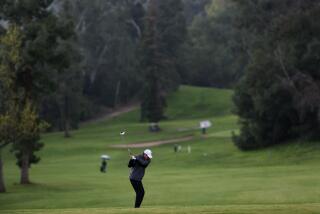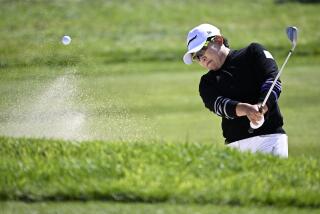GOLF : Slope System Puts a Different Slant on Establishing a Handicap
Slope used to mean, for a golfer, the tilt of a green on which he was about to putt, or the incline of a fairway he was trying to hit.
Now it means how difficult--or easy--a course is supposed to be. Slope is a refinement on the handicap system that has made golf such an extraordinary game in which lesser-quality players can play an equal match with a championship player--with strokes.
The Southern California Golf Assn. has incorporated slope into its handicap system this year, in keeping with nearly every golf organization in the country. Outside of Alaska, only Georgia’s august Augusta National course, home of the Masters, fails to recognize slope.
Finding a slope rating sounds confusing, but not if a player knows his index and how to convert that index into a handicap at the course he is playing. The index is a mathematical calculation that represents each golfer’s playing ability on a 113-slope golf course, a course of standard difficulty.
If a player played every round on a 113-slope course, his index and playing handicap would be the same. The U.S. Golf Assn., after compiling thousands of scores from courses all over the country, determined that 113 was the nation’s average. Among the 113-rated courses are Hillcrest Country Club from the white tees, Montebello from the blue tees and Bel-Air from the red tees.
“The slope rating brings more equity to the handicapping system, especially for the high-handicap player,” says Robert Thomas of the SCGA. “It makes little difference for a low handicapper and no difference whatsoever for a scratch golfer.
“The USGA is attempting to increase the credibility of handicaps by allowing for the difference in courses. There is no way to eliminate sandbagging--that is the province of the individual clubs--but slope does make it easier to match players more evenly.”
Each course has a slope rating chart posted where players can convert their index into a playing handicap for that round.
The highest slope rating in Southern California belongs, to the surprise of no one, to the stadium course at PGA West, which is rated 151. The back tees of Industry Hills’ Eisenhower course is second highest at 149.
They aren’t the highest in the country, however. The toughest is the International Golf Club of Massachusetts with 155, which is the maximum permitted on the USGA scale. Pine Valley, in New Jersey, which is always mentioned among the top five courses in the country, shares the runner-up 152 with Lagoon Legend in Florida.
Other high-rated Southern California courses include Coto de Caza, La Quinta Hotel’s Mountain course and the new Pacific course in San Clemente, 146; Desert Falls in Palm Desert and The Farms in Rancho Santa Fe, 145, and Bear Creek in Temecula, Industry Hills’ Zaharias course and Valencia, 144.
Riviera, where the Los Angeles Open is played, is rated 142 from where the pros play and 131 from the members’ tees.
Among the more heavily played Los Angeles municipal courses, Rancho Park is 108 from the white tees and 117 from the blues, Griffith Park Wilson 109 and 115, and Harding 105 and 110. Brookside No. 1 in Pasadena is 117 and 125.
The SCGA handicap committee re-rates about 325 courses on a five-year rotation.
“That means we are going to be making 70 to 80 ratings a year for the rest of our life,” Thomas said.
Distance is a factor in determining course difficulty, and courses are measured electronically. The SCGA has found some courses where the yardage is nowhere near what it says on the scorecard, a fact that some golfers find not surprising.
Among the other factors are the surface and target size of the greens, difficulty of the rough, size and position of trees, amount and position of water, width and slant of fairways, and number and position of bunkers.
“The system is based around what the USGA has found to be a profile of the average scratch golfer who shoots 70, and the average bogey golfer who shoots 90,” Thomas explained.
“For our purposes, a scratch golfer can drive the ball 250 yards, of which 225 is carry and 25 is roll; he can hit his second shot 220 yards and tends to draw the ball. The average bogey golfer drives the ball 200 yards, of which 180 is carry, and his approach shots do not carry more than 170 yards. He cannot carry a 380-yard hole in two shots and tends to slice the ball.”
Sound familiar?
Golf Notes
Glendora CC’s Pride of the Foothills tournament, one of the Southland’s prestigious annual events, will be held for the 19th time May 5-6. . . . Mike Rielly, whose father Pat is head professional at Annandale GC and brother Rick is head pro at Wilshire CC, has been transferred to Tokyo by the International Management Group, where he will assist such IMG clients as Arnold Palmer, Curtis Strange, Nick Faldo and Greg Norman in Asian real estate affairs. . . . Nine new holes, designated as the Stone House Nine, were opened last week at Temecula Creek Inn, making 27 holes available on the Riverside County resort course.
Applications for the U. S. Open are due Wednesday at USGA headquarters. Local qualifying will be May 21 at Industry Hills, Mission Hills in Rancho Mirage and Rams Hill in Borrego Springs. The Open will be played June 14-17 at Medinah CC, outside Chicago. . . . The U. S. National Senior Open Golf Assn. will hold its 20th annual spring championships May 15-17 at the Mission Hills, Palm Valley and Monterey CC courses in the Palm Springs area. John Kalinka of Honolulu is defending champion in the 54-hole event. . . . Senior amateurs will also play in the eighth annual Giddings Cup, starting Tuesday at the La Quinta Hotel’s Mountain course. Five-time winners Ed Updegraff and Dick Giddings are defending champions. Among the challengers will be Joe Simpson, runner-up in the U.S. Senior Amateur last year and the father of former U. S. Open winner Scott Simpson.
Master of ceremonies Monty Hall and several Raiders and Rams will help the Greater L.A. chapter of the National Foundation for Iletis and Colitis hold a charity celebrity tournament Monday at Riviera CC. Scheduled to play are Raiders Steve Beuerlein, Tim Brown and Willie Gault, Rams Mike Lansford and Brett Faryniarz and former Ram Carl Ekern. . . . When Arizona State freshman Brandie Burton lost the Sun Devil Invitational by a stroke to Kelly Robbins of Tulsa last week, it was the Rialto teen-ager’s first tournament loss as a collegian.
The U. S. Golf Assn. has ruled that one type of collapsible putter is legal, one is not. It ruled that a collapsible putter put together with a screw-type attachment--similar to that of a pool cue--is not acceptable. On the other hand, a putter that is collapsible in telescopic form may be used--but only in its fully extended position. The decisions were made because of the growing popularity of the long putter.
More to Read
Go beyond the scoreboard
Get the latest on L.A.'s teams in the daily Sports Report newsletter.
You may occasionally receive promotional content from the Los Angeles Times.










